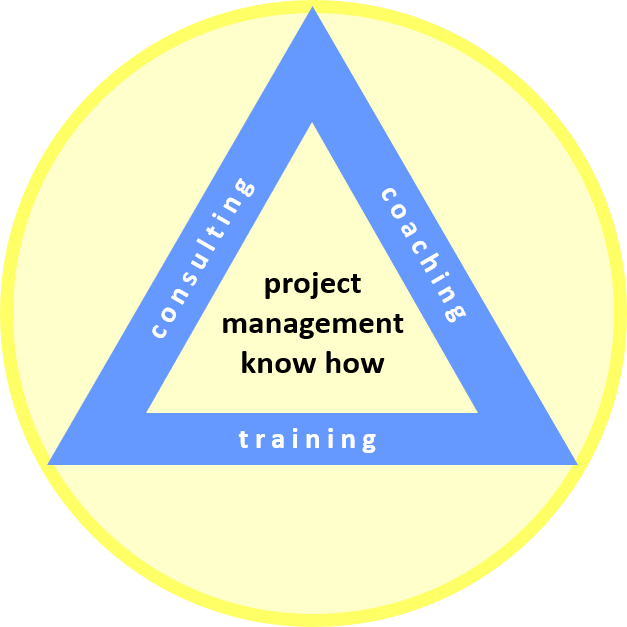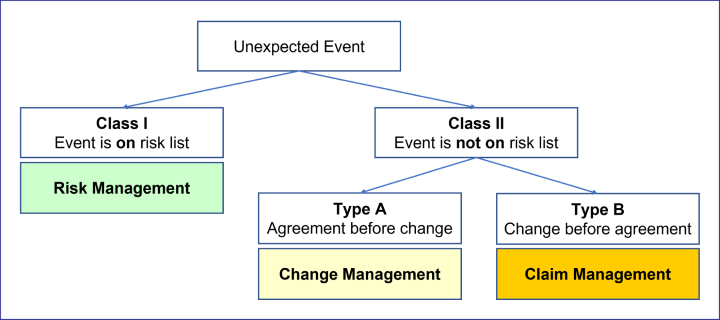- Home
- Planning Continued
Project Planning Continued
Published: 2022-04-21
Last updated: 2022-04-21
In this section, Project Planning Continued, we carry on with building further necessary plans that deal with contingencies.
We cover the following topics
- Project change, contract, and claim management
- Controlling tools
- Project communications plan
- Critical chain method
- Project management plan
- Tips on how to choose a project planning software package
At the end of the section Project Planning, we introduce the risk management process and risk analysis.
We “invent” preventive and corrective actions for all the risk events that make it onto our risk list. Then we integrate these actions into the WBS, and they become parts of the core planning documents.
At the same time, we know that there will be yet other events that are not addressed by risk management, either deliberately or because we cannot see them in advance.
So, there are two classes of contingencies:
Class I Those contingencies that are covered by the risk management process.
Class II Other contingencies that need to be handled by a different approach.
Project Change Management
(For further reference: component 13, project planning continued)
We know that certain unexpected events can happen after we started the implementation phase until we finish the project in the closure phase. And we also know that those events could change the project scope, schedule, or budget.
So, we have to prepare a project change management process that describes how we are going to deal with necessary changes resulting from unexpected events (the class II events).
Details on project change management
Project Contract Management
(For further reference: components 14 and 15, project planning continued)
Many projects are based on contracts between different legal entities, and thus, on contract structures set up in the definition phase. Now, we have to refine the contracts and their content to be able to handle changes resulting from unexpected events.
There are two types of changes:
A Changes the contract parties can agree to before implementing them
B Changes we implement before a mutual agreement between the contract parties
We embed the project change management process into the contract for the type-A changes, and a project claim management process for the type-B changes.
Details on project contract management
Details on project claim management
Planning the Controlling Tools
(For further reference: component 16, project planning continued)
There are a couple of tools available that support the controlling in the implementation and closure phase. It is worthwhile to spend some time in the project planning phase to plan which one of those tools we want to use for what kind of work package groups.
- Comparison of actual with planned quantities
- 0 – 100 % method
- 0 – 50 % – 100 % method
- Estimation of remaining effort and duration
- "Simple" tools, like work breakdown structure (WBS), network diagram, and Gantt chart
- Milestone Trend Analysis
- Earned Value Analysis (including schedule variance and cost variance)
Details on project controlling tools
Project Communication Plan
(For further reference: component 17, project planning continued)
In most projects, there are many stakeholders involved
- Project manager
- Team members
- Control board members
- Representatives of the customer
- Sub-suppliers
- And more …
To avoid confusion, we need a plan about who has to inform whom about what topics and when and how.
Details on the project communications plan
The Critical Chain Method
(For further reference: component 18, project planning continued)
You know from your own experience that the estimates of effort and duration of work packages can get “padded with hidden buffers”. Another troublesome phenomenon is the so-called “student syndrome”, describing a habit of starting work on an appointed task rather late.
The critical chain method, introduced by Eliyahu M. Goldratt in 1997, offers ideas that could be helpful.
Details on the critical chain method
Project Management Plan
The project management plan is the entirety of the planning components from 01 to 17 that we create in sections Project Planning and Project Planning Continued. Component 18 is optional.
Details on the project management plan
Software Support for Project Planning
While planning the project should be a joint effort of the whole project team, we use supporting planning software for our convenience.
We just need to make sure that we do not become slaves of a specific software package, but rather tailor the software to the requirements of the project and the team.
Details and tips on project planning software
Summary of Project Planning Continued
In the two sections, Project Planning and Project Planning Continued, we describe seventeen planning components, plus one that is optional.
These are
Twelve components of the core project plan:
- Product and work breakdown structure, PBS and WBS
- Effort estimation
- Milestone plan, network diagram, Gantt chart, including the analysis of the critical path
- Assigning resources
- Resource, cost, and payment plan
- Risk management process and risk analysis
And another five components to complement the project management plan:
- Project change, contract, and claim manament
- Controlling tools
- Project communications plan
Finally, we added three sub-sections about the topics
- Critical chain method
- Project management plan
- Tips on how to choose a project planning software package
This concludes the project planning phase, and we continue with the project implementation phase.
Traditional PM
Learning Path Navigation
|
|
|
Return from Project Planning Continued to Home Page
|
|
|


Your Comments
Have your say about what you just read! Leave me a comment in the box below.